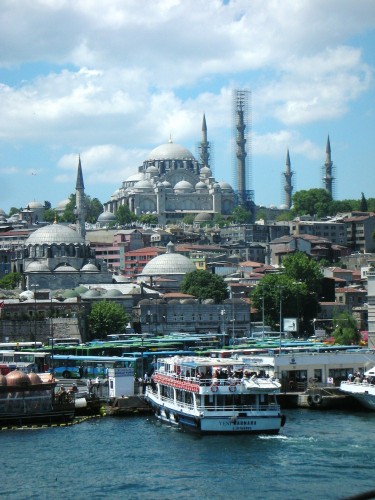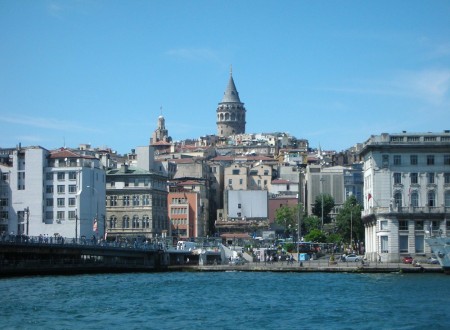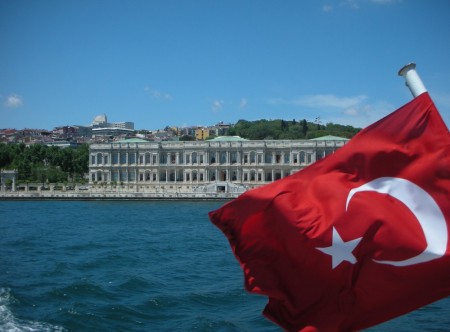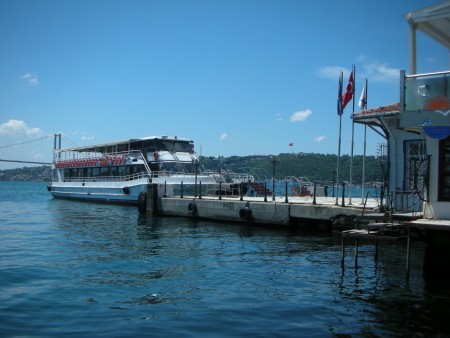After my experience two weeks earlier in the shining-yet-expensive-transportation city of Istanbul, Turkey, I made the solemn vow on the flight from Dushanbe to Istanbul that I would simply not go over twenty dollars, or about thirty Turkish lira, for my day in Turkey. To put it more simply, I couldn’t – I was down to my last $20 and I really didn’t have any idea how much I had withdrawn from my bank account while in Tajikistan. I was kind of a little worried to look, in fact. But I still had a fresh, crisp Jackson in my pocket and 10 hours to kill. I slapped my banknote down on the exchange counter and proudly received two notes in return, a twenty lira and a tenner.
So what to do? Thanks to my mother’s advice while I had been in Tajikistan and the remarkable online guide to everything in Turkey, I knew that there was a subway/metro transport system, somewhere in the bowels of the airport, that for about 2.8 lira could get me all the way to the Sultanahmet’s vicinity, and the same fare would take me back to the airport as well. A slightly better deal than the 90 lira “deal” that shifty Murod and Co. had whipped up for me two weeks previously. If I had seen any of that group on my way to the lower levels of the airport, I would have gladly taught them a few choice Arabic phrases.
The clearly-marked, clean metro rail smoothly carried me exactly where I expected to go – the Eminonu bridge just beyond the Sultanahmet Mosque and the Hagia Sofia. I wandered across the wide bridge, cars and metros buzzing past next to me. Just like the previous time, I was in awe of the towering, majestic mosques with their flying, no, soaring buttresses and domes that are built so close together that it’s almost like they’re on top of each other. I stared into Bosphorus Strait at the specks of buildings in the distance and pondered the best way to find a boat across that wouldn’t cause me to go over my self-imposed budget. As I looked around for inspiration, I caught a glimpse of a tall, interesting-looking tower in the distance on my side of the strait. Shouldering my pack, I started up the hill for it.
It turned out to be an ancient watchtower, the Galata Kulesi, billed as the “oldest tourable tower in the entire world.” Whether you’re counting the original wooden structure built in 528 AD as a lighthouse or the stone tower built in the same place in 1348 makes a big difference though, I suspect. I paid my 10 lira entry fee, noting with wry amusement the now-familiar ploy of non-English-speaking tourist locations to write out the price numerically in English (“This is 10 lira entry”) but above it literally spell out the price, in Turkish – in this case, beş, or “besh” as we’d say it, which means “five lira.” I got used to this technique in Petra, where the price for people who read English is 22 dinars, but for Arab-reading nationals of Jordan, 1/22 of that price. As far as I know, America has never charged different prices for different nationals for tourist locations…has it?
The view from the top was great, although a little cramped. The little walkway around the top had been almost entirely removed during renovations, which I cynically believe was to make room for the bar and nightclub that now occupy the top floor. Something tells me the Turks can make a lot more money from selling 8 lira glasses of beer and 20 lira glasses of wine in an evening than selling their tickets. But no matter – I was happy to be able to walk in a full 360 degree loop to see the cityscape laid out for me. One moment, I was looking into Asia, the next moment, back into Europe where I was currently standing. The experience was slightly marred by some American tourists, a group of maybe a half-dozen college-aged women who continuously complained to their guide that their feet hurt, that the air smelled funny, and that they wanted to go back to the hotel and watch TV. What a long way down to fall off the side of this tower, I mused thoughtfully.
I left the tower and its expensive refrigerator magnet souvenirs behind, and meandered back towards the Golden Horn Strait (the Bosphorus’s little brother that I had just walked over). A street vendor offered me a gyros/schwarma-like sandwich stuffed with lamb meat, which I thought I was accepting for three lira but found that the price written on the wall behind him had magically become 4 lira in the 15 minutes while I sat and ate. Rolling my eyes, I paid the man – I figured I had walked into that one and I should have expected that to happen to me here in Istanbul.
Checking my watch after lunch, I saw that I still had a good 3 hours left before I should try to return to the airport. I paid another 2.8 lira for two ferry tokens, the basic transport ferry which left every half hour. Frankly, that was the best part of the day right there – I rode up the Bosphorus for 45 minutes, snapping pictures of the luxurious houses and villas along the coastline on both sides, and under the huge steel suspension bridge with tiny beetle-like cars flitting over it high over our heads. If only I had brought my sweater with me, it would have been perfect; the air got quite chilly for me in my t-shirt.
When we arrived with a bump at the Çengelköy port on the Asian side of the strait, I stretched happily and offhandedly mentioned to a woman nearby me that it was the best lira and a half that I had spent. She snorted and said, “Not such a good deal if you paid 60 lira.” I gaped at her while she explained that she and her husband and daughter had each paid 20 lira to take the scenic guided tour along the coast, but at the dock the handlers had (apparently) directed them onto the wrong ferry and now their dated tickets had expired. They were understandably displeased, and as I chatted with the three of them, we realized that we had all detected a palatable level of distaste for Americans here in Istanbul. I was surprised, almost dumbfounded – in all my months in the Middle East, I had never felt like I was disliked just because of where I came from, but here in the European cultural center of Turkey, I realized that these three tourists were right – there was a careless, generalized dislike of Americans that I could see in everyone’s eyes. Sure they liked our money, but it was a case where few would help you or give you advice if you were about to, say, waste 56 lira by climbing onto the wrong ferry. I sadly sipped at a 2 lira can of Coca-Cola and stared out across the strait back at Europe. I missed Jordan, Tajikistan, and America all at the same time, and felt very alone.
After half an hour of watching the boats glide across the water, the same ferry that had carried us few passengers across in the first place was ready to head back. I used my second ferry token and joined the three Americans for the return trip, where they sat somewhat morosely and sipped at tea served by a jovial attendant. I bought a 5 lira can of beer from him, and drank it slowly while I read my Dune book, the chilly wind playing with its pages. The boat was almost empty: like the vendor in the Kaplicharshi had told me two weeks earlier, this was the dry season for tourism and there were few tourists or natives willing to bother with the scenic ride when there was a bridge right over our heads.
Same as it had that morning, the ride back to the airport in the metro was smooth and uneventful: a good end to an action-packed two week trip through three different countries, and along the river bordering a fourth. Checking through my wallet and funds, I was pleased to see that I had succeeded in my financial goal: I had spent 29.60 lira for the day’s activities, staying under my goal by 40 kuruş (cents).
I was tired enough that I requested coffee several times on my last flight back home back to Amman, but I made good on my (other) promise to myself to finish the last book in the Dune trilogy somewhere over the Mediterranean Sea. I was entertained by my seatmate, a buoyant young Danish archeology grad student who was on his way to Jordan with his classmates to study the ruins of Jerash, who was overjoyed when I shared my photos from my previous trip with him and was practically dancing in his seat, exclaiming in his accented drawl that he couldn’t wait to land and get started. Suddenly, he got a worried look in his eyes, and he leaned conspiratorially towards me over the armrest and whispered, “What do you think the gay scene is like in Jordan? Am I going to be okay, or are people going to try to beat me up?” I assured him of his safety and helpfully tried to give him the names of a few gay bars in Amman, trying to remember them as the ones that Haitham had once told me “NEVER GO IN THESE PLACES.” Just like the fact that there’s no drinking age in Jordan because the government refuses to acknowledge that anyone drinks alcohol in Jordan, there is no official policy on gay bars either because people prefer to put their fingers in their ears and sing loudly when the topic comes up.
At around half past ten, the plane touched down in Jordan and I was home, back in my familiar desert with my familiar procrastinating bus system that took another two hours to send a bus to the airport to pick up the assembled crowd: me and one other person. The owner of the company had even driven to the airport, apologized to me personally for the wait, and proceeded to yell obscenities at his drivers through his mobile while shaking my hand repeatedly and thanking me for coming to Jordan. Ahhh, Jordan. Lord knows you drive me bonkers sometimes but I love you anyway. It’s good to be home.






No one has commented on this post - please leave me one, I love getting feedback!
Follow this post's comments, or leave a Trackback from your site